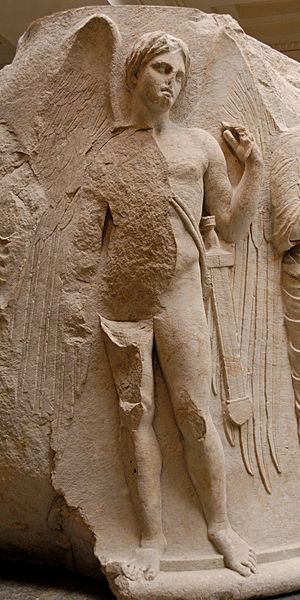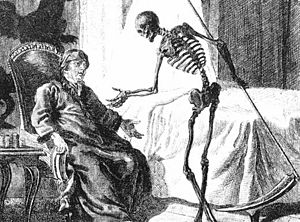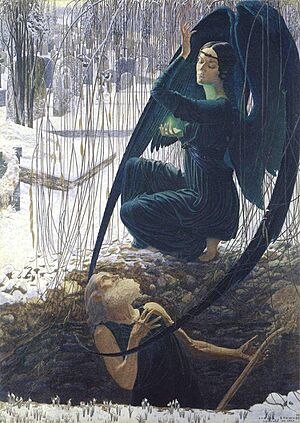Death (personification) facts for kids
Death is often shown as a person or creature in stories and beliefs around the world. In English, this figure is usually called the Grim Reaper. Since the 1400s, the Grim Reaper has often been pictured as a skeleton wearing a black cloak with a hood and carrying a scythe (a long curved blade). This figure is also sometimes called the Angel of Death, especially in the Bible.
Some stories say the Grim Reaper causes death. This led to legends where people try to bribe, trick, or make deals with Death to save a life. In other beliefs, the Grim Reaper simply guides the souls of the dead to the next world. The dead person might not even know they have passed away.
Contents
Death in Ancient Stories
Ancient Greek Beliefs

In Ancient Greece, people often saw death as a natural part of life. The god of death was Thanatos. He was usually shown as a bearded man or a young boy with wings. Thanatos was the twin brother of Hypnos, the god of Sleep.
Thanatos was seen as gentle. He would escort the dead to the Underworld, known as Hades. There, he would hand them over to Charon. Charon was the ferryman who took souls across the river Styx to the land of the dead. Thanatos also had sisters called Keres. They were spirits of violent death, linked to deaths from battles, sickness, accidents, or murder. The Keres were often shown as evil, with fangs and talons.
Roman Mythology
In Roman mythology, the figure of Death was known as Mors. Mors was the Roman version of the Greek god Thanatos. Even though the Latin word for "death" (mors) is feminine, ancient Roman art does not usually show Death as a woman.
Celtic Stories
The Welsh called death Angeu, and the Bretons called him Ankou. He appeared as a man in a black robe, sometimes with a scythe. He rode a cart where he collected the dead.
In Scottish folklore, some people believed in a mystic black, dark green, or white dog called Cù Sìth. This dog was thought to take dying souls to the afterlife. Similar dog figures also appear in Irish and Welsh stories.
Death in Poland
In Poland, Death, or Śmierć, looks much like the modern Grim Reaper. However, instead of a black robe, Śmierć wears a white robe.
Baltic Legends
Lithuanians called death Giltinė, which means "to sting." Giltinė was shown as an old, ugly woman with a long blue nose and a poisonous tongue. A legend says that Giltinė was once young and pretty. But she was trapped in a coffin for seven years, which changed her. Giltinė was also the sister of Laima, the goddess of life and destiny. This showed the link between beginnings and endings. Later, Lithuanians adopted the classic Grim Reaper with a black cloak and scythe.
Hindu Texts
In Hindu texts, the lord of death is called Yama. Yama rides a black buffalo and carries a rope to take the dead to his prison. His agents, called Yamaduts, also collect souls. In Yama's court, all good and bad deeds are recorded. Yama then decides where a soul will go in its next life, based on the idea of Reincarnation.
Japanese Mythology
In the ancient Japanese text called the Kojiki, the goddess Izanami dies after giving birth to the fire god. She then goes to the underworld, called Yomi-no-kuni. Her husband, Izanagi, tries to bring her back but fails. Izanami promises to take a thousand lives every day, showing her role as a goddess of death.
There are also death gods called shinigami (死神, "death gods" or "death spirits"). These are more like the Western idea of the Grim Reaper. While common in modern Japanese stories and art, they were not a big part of traditional mythology.
Death in Abrahamic Religions
Memitim
Memitim are a type of angel mentioned in the Bible that are linked to human death. The word comes from the Hebrew word for "killers." They are said to kill people whose guardian angels no longer protect them. While scholars discuss their exact nature, it is agreed that they are a type of killer, as described in the Book of Job 33:22.
Judaism
Form and Functions
According to Jewish tradition (Midrash), the Angel of Death was created by God on the first day of creation. This angel lives in Heaven and has twelve wings. God told the Angel of Death, "I have given you power over all people, except for those who have found freedom from death through the Law."
The Angel of Death is said to be full of eyes. When someone is dying, the angel stands over them, waiting for the person to see him. When the dying person finally sees the angel, a drop of gall (a bitter liquid) falls into their mouth. This is what finally causes their death. The saying "to taste of death" comes from this idea.
Death and Satan
The Angel of Death is sometimes identified with Satan. After creation, the Angel of Death argued with God about the light of the Messiah. When Eve touched the tree of knowledge, the Angel of Death spoke to her. She thought, "Now I shall die, and God will create another wife for Adam." Adam also spoke to the Angel of Death. The Angel of Death sits before the face of the dead. When Abraham was mourning for Sarah, the angel appeared to him.
Moses often dealt with the Angel of Death. He saw the angel during the resistance of Korah.
Christianity

In Christianity, some early beliefs suggested there was no specific creature for death. This was because God resurrected Jesus and has power over life and death. However, the author of the Epistle to the Hebrews stated that Satan had the power to control death. Some believed that The Son, through his death, defeated Satan. Then, through his resurrection, he brought Satan back to life.
It is also believed that the first head of the Beast in the Book of Revelation represents the resurrection of Satan.
Islam
In Islam, there is an Angel of Death, often known as the Archangel Azrael. In the Quran, he is not mentioned by name but as Mal'akkh al Mut (Arabic: ملاك الموت, "Angel of Death"). He is also described as Azrael in old Hebrew and early Christian texts.
Images for kids
-
Statue of Death, personified as a human skeleton dressed in a shroud and clutching a scythe, from the Cathedral of Trier in Trier, Germany
-
Yama, the Hindu lord of death, presiding over his court in hell
-
Gustave Doré Death on the Pale Horse (1865) – The fourth Horseman of the Apocalypse
See also
 In Spanish: Muerte (personificación) para niños
In Spanish: Muerte (personificación) para niños











